Núria Prat and Pere de Llobet
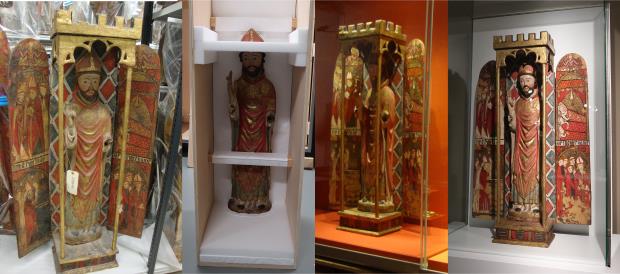
The Altarpiece-tabernacle of Saint Nicholas is a work that was kept in the Museu Nacional’s storeroom for years. It entered the Museu d’Art de Catalunya (now the Museu Nacional) in 1934, as a donation by the collector Damià Mateu i Bisa. We know that the work was on display in 1936, as it appears in the Museu d’Art de Catalunya’s catalogue of that year. It was also exhibited in the 1970s, as stated in the museum guide of 1973. In recent decades the tabernacle-altarpiece has been moved from place to place, but always in storage, going unnoticed along with other sculptural carvings, hoping that one day its moment of glory will come again: on display to the public!
In 2017 the work was timidly brought out to show the public how the museum conserves works of art in its storerooms. It was chosen for the exhibition The Entropic Box (The Museum of Lost Objects), curated by Francesc Torres, which was on at the Museu Nacional from 20 October 2017 to 14 January 2018. In one of the sections, there was a shelf, like those in the sculpture storeroom, on which a group of sculptures including the Tabernacle-altarpiece of Saint Nicholas were placed. They were all individually wrapped in polyester film, open at the bottom. It is harmless archive plastic, perfect for protecting documents and works of art from dust particles and storing them. As it is transparent it allows the whole work to be seen without having to handle it during preventive conservation controls or when curators or researchers have to gain access to it
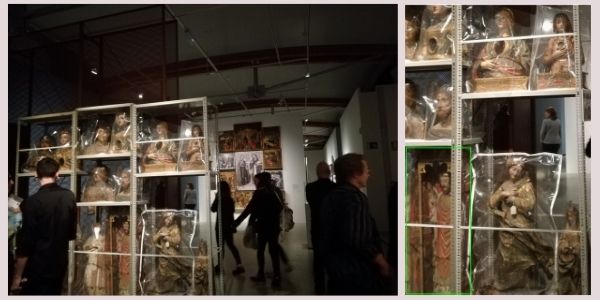
The Museu Episcopal de Vic and the Catharijneconvent Museum in Utrecht are programming the exhibition of medieval art North & South: Medieval Art from Norway and Catalonia, 1100-1350. Part of this exhibition focuses on tabernacle-altarpieces, and so the Tabernacle-altarpiece of Saint Nicholas was chosen for inclusion in the show. Different forms of contact were established between the experts of the two museums and the specialists of the Museu Nacional. In January 2019 a delegation from the Catharijneconvent came to the museum and visited the paintwork restoration rooms, where the work was being restored, in order to examine it in detail.

The Tabernacle and the Carving
An examination with the naked eye revealed that both the baldachin and the carving seem to be made of hardwood, probably black poplar. It was impossible to identify from the carving, as it was completely plastered and polychromed. The tabernacle is long and rectangular, and crowned by a gilded canopy topped with battlements, supported by two slender columns, also gilded. It had double doors on either side. Inside it, the carving of Saint Nicholas was attached to the wood at the back of the tabernacle. When the wings were closed, the carving was enclosed. The outer doors, which close the front, have been lost. The inner wall of the tabernacle is decorated with red and blue lozenges, framed in white and outlined in black. Imitation gilt ochre-coloured stars have been drawn inside the lozenges. The ceiling of the canopy, or roof of the tabernacle, is decorated with a large white star outlined in red. The part of the interior wall of the tabernacle that is hidden by the carving is not decorated. As it is not visible, this area has simply been painted blue.
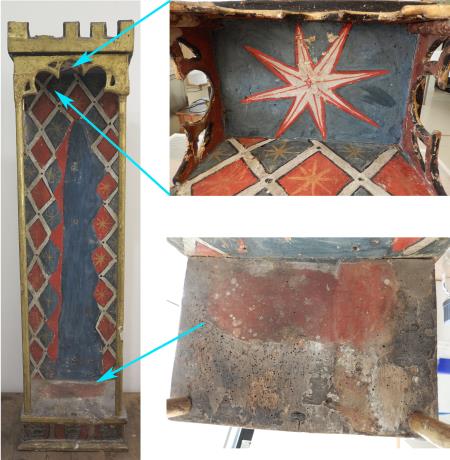
As regards the state of conservation of the tabernacle and the carving, we can say that holes made by apparently inactive woodworm were observed. As a preventive measure, the whole piece was subjected to disinsectization by anoxia, and a nitrogen-modified atmosphere was maintained inside an airtight chamber for 600 hours (the parameters of the cycle are the following: a temperature of 23<25° C; relative humidity of 55<60%; less than 0.1% oxygen). In this way the death is guaranteed of the xylophagous insects and of any eggs there may be inside it.
The polychromy and the gilt presented widespread attachment problems: they were very dry, dirty, and small areas had been lost. The area of the base of the tabernacle and the bottom of the carving were the two areas where the accumulated dirt was concentrated (dust stuck to them, atmospheric pollution, etc.).

The bottom half of the carving of Saint Nicholas presented remains of wax; many were also found on the base of the tabernacle. These drops of wax were very likely from devotional candles. Wax hardens over time and, as it is a greasy material, the dirt in the atmosphere sticks to it easily.
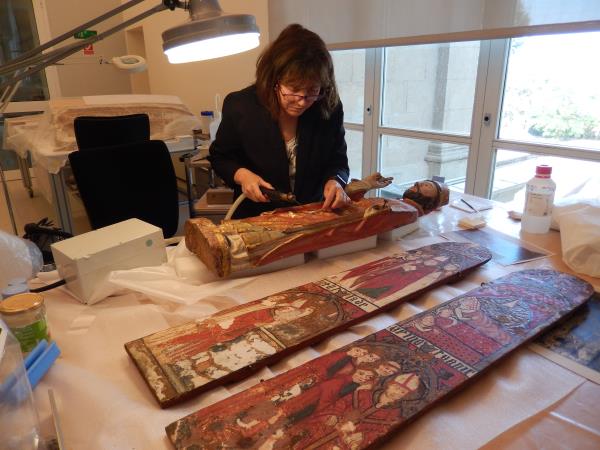
The volumetric reconstruction of a battlement
In general, when a decorative element has been lost from a panel painting or a carving, and, as is the case here, the tabernacle battlement, the museum’s conservation-restoration work tends not to replace it. This was the initial criterion in this case, but upon observing the work we realized that our eyes were drawn automatically towards that point and that it was distracting for observers. This is why it was eventually decided to replace the battlement, but only volumetrically. A piece of wood identical to the other battlements was cut out but it was not gilded. The new battlement was stuck on with strong carpenter’s glue mixed with very fine wood dust to refill the gaps in the support.
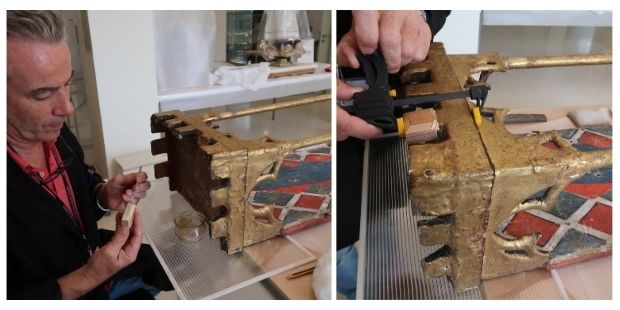
The wood was coloured directly with shades of ochre, through the superimposition of glazes.
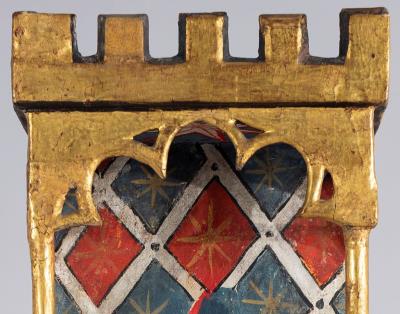
As for the stages of the restoration work, such as the attachment and cleaning of the polychromy and gilt, the puttying and infilling of the paintwork of the whole work, all this was done with the objective of interfering as little as possible in the vicissitudes that the work had undergone, and also of restoring the work as closely as possible to its original state. At all times the criterion of minimum intervention was applied.
While we were doing the conservation-restoration work on the piece, we were joined by Á. P. Pombar, a student from the Galician School for the Conservation and Restoration of Cultural Heritage working in the department as a trainee, and he had the opportunity to take part in some stages of the restoration of the tabernacle. Animal glue was applied to the unstable areas of the work with both the syringe and the brush, in order to stabilize them.
To clean the polychrome different buffer solutions were used, both aqueous and mixtures of solvents. The gilded areas, covered in a thick layer of dirt, were only cleaned with solvents, because gold leaf is very sensitive to water and it would have been damaged.

A puzzling seal-stamp
On the base of the tabernacle, the mark of a round seal or stamp can be seen on the wood, but it is illegible because the lettering is not clear. It was documented photographically, and the museum’s Department of registration of works of art (Jordi Casanovas DP) and the museum’s Folch i Torres Library (Yolanda Ruiz) were asked to help. The search for the stamp was successful and, due to its similarity, it seems that it could be the seal used from 1936 onwards, when the Barcelona Museums Board was abolished and the General Commissariat of Museums was created under the direction of Pere Coromines. With the start of the Civil War, the principal mission was that of safeguarding works of art, documents and books in different places in Catalonia. The works of art in the Museu d’Art de Catalunya (now the MNAC) were moved from the Palau Nacional to Olot to keep them safe from the bombing raids on Barcelona.
This seal was habitually used to mark documents and books, but it was not stamped on works of art. How did it come to be on our tabernacle

Related links
North & South. Mediaeval Art of Norway and Catalonia 1100-1350
Medievalia. Revista de Estudios Medievales, Vol. 23, Núm.1
“Una torre per a un bisbe universal”, Favà, Cèsar. North & South : medieval art from Norway and Catalonia 1100-1350 / editors: Justin Kroesen, Micha Leeflang, Marc Sureda i Jubany. [2019] [exhibition catalog, p. 123-125, cat. núm. 14 fig. P.123. ].
Pere de Llobet
and
Restauració i Conservació Preventiva







